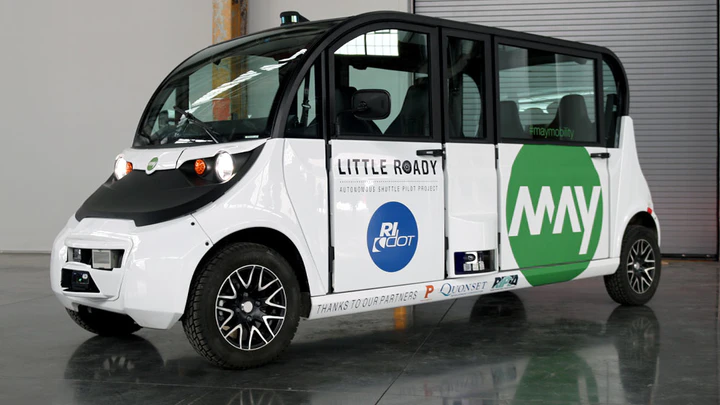Will you let a robot give you a ride?
Project Summary
Autonomous vehicles were piloted in Providence, Rhode Island in 2019-2020. Dubbed the “Little Roady” project, the pilot offered free rides on an autonomous shuttle along a 12-stop, 5.3 mile fixed route between Olneyville Square and the Providence Train Station. The Policy Lab helped policymakers understand why some individuals are more open to autonomous vehicles than others.
Why is this issue important?
Your rideshare vehicle pulls up, you open the door, and the driver’s seat is empty. Are you getting in? Cars that drive themselves—autonomous vehicles (AVs)—are designed (or at least marketed by their creators) to make roads safer, drivers more productive, and the air cleaner. If the technology becomes widespread and lives up to the hype, it'll transform how people move around and how transportation systems get built and managed.
However, early polling has found that most Americans are worried about AVs.1 As policymakers consider whether and how to introduce AVs onto public roads, this project aimed to understand why some individuals are more open to AVs than others.
What did we do?
Autonomous vehicles were piloted in Providence, Rhode Island in 2019-2020. Dubbed the “Little Roady” project, the pilot offered free rides on an autonomous shuttle along a 12-stop, 5.3 mile fixed route between Olneyville Square and the Providence Train Station. The 6-passenger electric shuttle operated autonomously, but it also had a human “fleet attendant” onboard, well, just in case.

Throughout the pilot, the research team surveyed people as they were riding the shuttle, and we also asked a convenience sample of nearby community members about their perceptions of the AVs. Hundreds of people shared their opinions. There was, in parallel, a statewide survey of 500 Rhode Islanders and a nationally representative survey of 1,000 Americans. We also conducted focus groups with Rhode Island public transit drivers and policy-makers, coupled with briefings about the technology. (See the pre-analysis plan for details.)
What did we learn?
About 4 in 5 people familiar with Little Roady expressed interest in riding the autonomous shuttle. Those who took a ride reported mostly positive experiences. Anecdotally we encountered confusion about how the technology worked; for example, it was not always clear to the riders how often the human attendant had to take over control of the vehicle and drive it manually. Nonetheless most people (77%) predicted that riding in an AV would ultimately be as or more safe than driving themselves, an assessment that is slightly higher than the 71% who say riding a public bus is as or more safe than driving themselves.
The statewide and national surveys, in contrast, found that only 28% of people had any interest in riding an AV. Concerns about safety, not only for riders but also cyclists and pedestrians, were expressed more frequently. There was skepticism that AVs would reduce traffic or lower transportation costs. People familiar with AV technology were more likely to be optimistic. An experiment embedded in the surveys (see the project brief for details) found that sharing positive press about AVs did not affect opinions, while press on downsides of the technology further lowered interest in taking a ride.
What happens next?
The state of AV technology continues to evolve, and more pilot projects are happening across the country. Our results suggest that pilot projects—letting people actually see and touch the technology in action—may generate more public understanding and support than information campaigns arguing the theoretical costs and benefits of AVs. And piloting stands to have even more benefits for policymakers: this is a complicated and rapidly evolving technology, and it’s impossible to predict every issue that may surface in adopting an AV program. Rather than rushing into a fully scaled program, governments would be wise to start with smaller scale pilots, to learn what does and does not work for their local context. They may even conclude that AVs are not well fit at all for their community.
There are many unsettled questions about how to design and fund AV infrastructure, including tradeoffs to consider against other public transportation options. Democratic debate on these questions can be difficult if regulators and the wider public do not have full information about how a proposed AV technology does (and does not) work. To that end, governments conducting a pilot project should require that performance data—about how frequently and under what conditions the AV has to rely on human intervention; how and why accidents occur; impacts on traffic congestion; and so forth—be collected, shared with regulators, and posted publicly. And given our results, AV firms themselves should want to share: more transparency seems to increase support, even when uncovering limitations.
-
Aaron Smith and Monica Anderson, “Automation in Everyday Life” (Pew Research Center, October 2017).
↩
How to cite this Project: The Policy Lab. (2021, February 22). Will you let a robot give you a ride?. The Policy Lab. https://thepolicylab.brown.edu/projects/little-roady

